P. Jenniskens [1], N. Moskovitz [2]
- SETI Institute; 2. Lowell Observatory
Abstract: In addition to enhanced Andromedid (AND#0018) activity since November 20, 2021, we report here that an outburst of mainly faint meteors was detected over Northern America by northern hemisphere networks of the CAMS video orbit survey on November 28. The outburst was centered on solar longitude 245.887 ± 0.007 deg (05:18 ± 0:10 UTC) and had a Full Width at Half Maximum of 4.0 ± 0.5 h. The mean magnitude was +1.6 and magnitude distribution index was 3.8 ± 0.3.
Introduction
During most years the Andromedids display a low annual activity in early November. This meteor shower is best known from the impressive meteor storms in 1872 and 1885 that occurred shortly after the fragmentation of parent comet 3D/Biela (Jenniskens, 2006). In recent years, unusual Andromedid activity has been detected in late November and early December in 2011 and 2013 (Wiegert et al., 2013; Brown, 2013). The exact cause of those events is a topic of active research. Now, a new outburst was detected that may help find an answer.
Methods
The Andromedid activity, a northern hemisphere shower, was monitored by the northern hemisphere networks of the CAMS video-based meteoroid orbit survey. Meteor trajectories were calculated from low-light video observations (Jenniskens et al., 2011). Most video-detected meteors are of magnitude +4 to -5. Radiant positions and speed are reported in near-real time at: http://cams.seti.org/FDL/
In recent years, the CAMS BeNeLux and LO-CAMS networks have included the use of the CAMS-compatible RMS cameras and the triangulations among those RMS cameras are also reported by the Global Meteor Network (Vida et al., 2021). That network also detected the enhanced Andromedid activity. Results are reported at: https://globalmeteornetwork.org/data/
Northern hemisphere meteor showers are also monitored by the Canadian Meteor Orbit radar (Brown et al., 2008). The radar is sensitive to about +5 to +10th magnitude meteors caused by smaller particles than are detected by video. Radiant and speed results are reported in near-real time at: https://fireballs.ndc.nasa.gov/cmor-radiants/
Results
We reported earlier that the first Andromedid activity in 2021 was detected on October 28, gradually increasing to a broad maximum around November 9. After that, rates declined until a reversal occurred and rates started to increase again (Jenniskens, 2021a, 2021b).
On November 28, CMOR detected a strong outburst from the Andromedid shower (Figure 1). Brown (2021) reported by tweet that the outburst was “very rich in fainter meteors. Peak occurred between 6-7 UT, Nov 28 with ZHRs in excess of 100. Hundreds of AND orbits have been recorded. Strongest outburst of AND ever detected by CMOR. AND activity has been high as measured by CMOR the last 10 days, but plateaued in previous 4 days. Last night’s sharp outburst was several times above the broad outburst peak of the last days.”
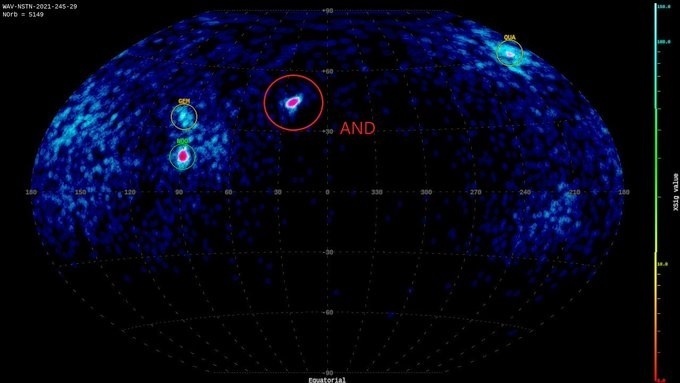
Figure 1 – The Andromedid 2021 outburst recorded by CMOR on November 28.
That night, the CAMS video-based meteoroid orbit surveys in Arizona and California had clear weather and triangulated 122 Andromedids between 1h30m and 11h55m UTC (See Figure 2 and http://cams.seti.org/FDL/ for the date of 2021 Nov. 28).
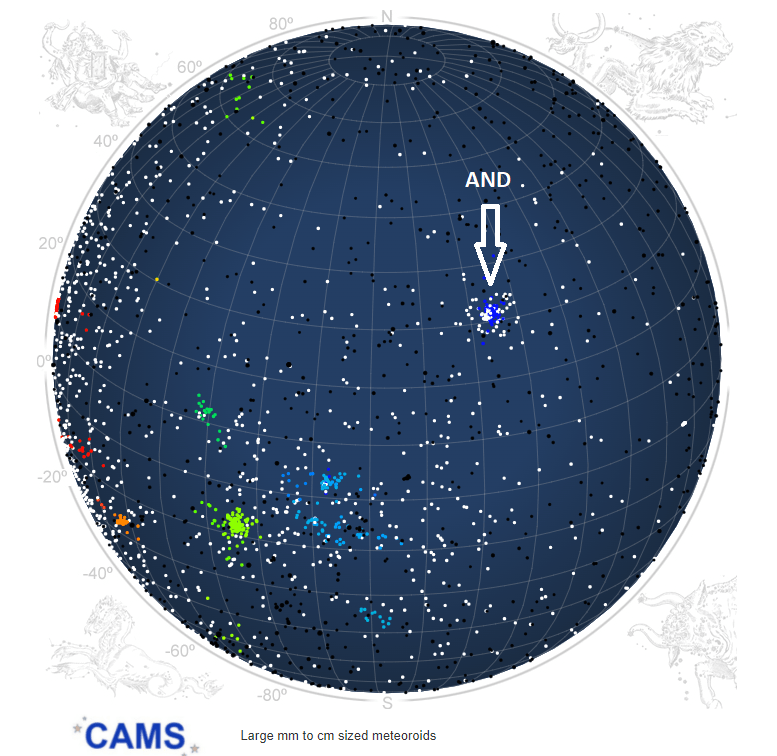
Figure2 – The high Andromedid activity created a dense cluster of radiant points on the map.
Both CAMS networks detected a spike in rates during the night of November 27-28 over that seen in previous nights. Figure 3 shows the rate of Andromedids relative to that of sporadic meteors by blue points (on a logarithmic scale). The solid line is a 3-gaussian component fit centered on Nov. 9, 25 and 28.22, respectively, with relative peak activity 0.016, 0.025, and 0.19, and sigma 6.3, 3.2 and 0.087 days.
The graph also shows the raw CMOR counts for each day, which were offset to align with those of CAMS. Note that CMOR followed the CAMS-detected increase of rates after Nov 20 and also detected the spike in activity. The CMOR-detected spike appears broader, but it probably isn’t. The time-dependence of that spike and the actual peak CMOR rate on November 28 are unresolved in the published figures.
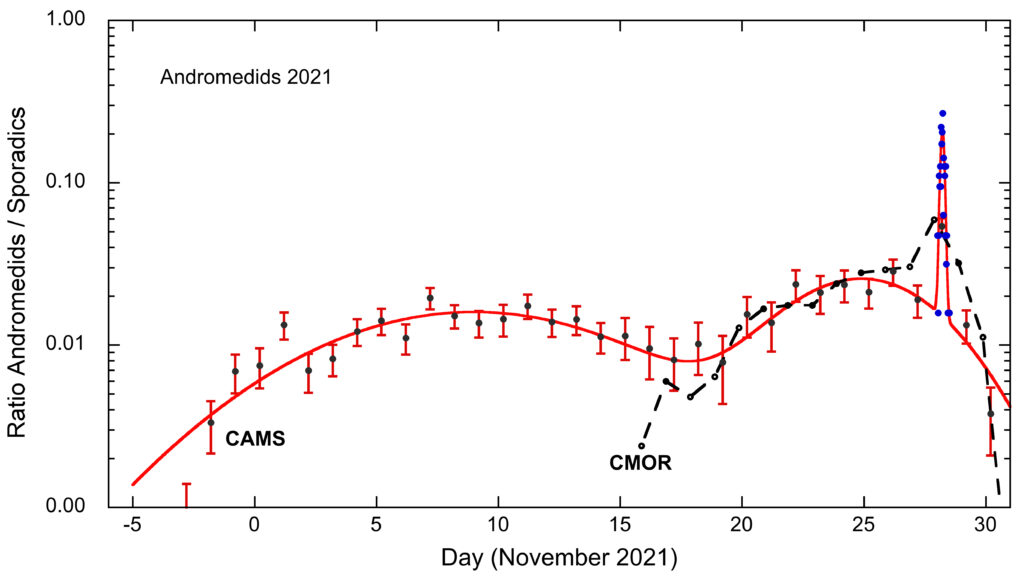
Figure 3 – The Andromedid 2021 rates relative to the sporadic background, recorded by CAMS and CMOR.
The distribution of CAMS-triangulated Andromedids on November 28 is relatively narrow and stands out above previous rates. The distribution is centered on 05h18m ± 10m UTC, corresponding to solar longitude 245.887 ± 0.007 deg (equinox J2000.0) with a full-width-at-half-maximum of only 4.0 ± 0.5 hours. The meteors radiated from a geocentric radiant in the constellation Andromeda at R.A. = 25.8 ± 2.2 deg, Decl. = +44.7 ± 1.3 degrees (equinox J2000.0) with geocentric velocity 16.7 ± 3.1 km/s. Median orbital elements were;
- a = 3.8 AU,
- q = 0.858 ± 0.018 AU,
- e = 0.771 ± 0.181,
- i = 13.6 ± 1.9 deg,
- ω = 225.7 ± 1.9 deg,
- Ω = 245.87 ± 0.09 deg (equinox J2000.0).
Most were faint meteors with a steep magnitude distribution index 3.8 ± 0.3. The mean magnitude of the CAMS-detected Andromedids was +1.6. The outburst could be seen also by the naked eye in clear dark skies where the radiant was above the horizon at that time.
Starting on December 1, the CMOR detected Andromedid rate has significantly decreased. CAMS is still seeing some Andromedids. Based on past CAMS-detected outburst activity (see “Past Data” on http://cams.seti.org/FDL/), the shower may remain active until about Dec. 6.
Discussion
The cause of the sharp peak and the broad underlaying outburst components are not yet explained. Based on a model that explained the 2011 and 2013 outburst activity with dust trail encounters of the 17th century ejecta prior to the discovery of 3D/Biela (Wiegert et al., 2013), there was no unusual activity expected for 2021. It is possible that the 2021 activity disproves that explanation.
The November 28, 2021, outburst occurred at a solar longitude slightly below that of the 1872 (247.713) and 1885 (247.336) meteor storms. The past Andromedid storms were due to the active fragments of 3D/Biela in the 1846 and 1852 returns (Jenniskens & Vaubaillon, 2007), not due to dust generated in the fragmentation of 3D/Biela itself. Perhaps that dust played a role in the activity observed this year. It is also possible that the final breakup of 3D/Biela after the last sightings may be responsible, or even other activity that predates the first sighting of the comet.
Acknowledgements – Congratulations to all CAMS station operators for this interesting detection.
References
Brown P., Weryk R. J., Wong D. K., Jones J. (2008) A meteoroid stream survey using the Canadian Meteor Orbit Radar. I. Methodology and radiant catalogue. Icarus 195, 317–339.
Brown P. (2013) Andromedid Meteors. CBET 3741, D. W. E. Green (ed.), Central Bureau for Astronomical Telegrams, pp 1-1.
Brown P. (2021) Tweets on topic of Andromedids. November 28, 2021. c.f.: https://twitter.com/pgbrown
Jenniskens P. (2006). “Meteor Showers and their Parent Comets”, Cambridge University Press, Cambridge, 790 pp.
Jenniskens P., Vaubaillon J. (2000). “3D/Biela and the Andromedids: Fragmenting versus sublimating comets. Astron. Journal 134, 1037–1045.
Jenniskens P., Gural P. S., Dynneson, L., Grigsby, B. J., Newman, K. E., Borden, M., Koop, M., Holman D. (2011). “CAMS: Cameras for Allsky Meteor Surveillance to establish minor meteor showers.” Icarus 216, 40–61.
Jenniskens P. (2021a). “Andromedid meteor shower 2021”. CBET 5072, D. W. E. Green (ed.), Central Bureau for Astronomical Telegrams, pp 1-1.
Jenniskens P. (2021b). “An outburst of Andromedids (AND#0018) in 2021”. eMetN, 7, submitted.
Vida D., Šegon D., Gural P.S., Brown P. G., McIntyre M. J. M., Dijkema T. J., Pavletić L., Kukić P., Mazur M. J., Eschman P., Roggemans P., Merlak A., Zubrović D. (2021). “The Global Meteor Network – Methodology and First Results”. Monthly Notices of the Royal Astronomical Society, 506, 5046–5074.
Wiegert P. A., Brown P. G., Weryk R. J., Wong D. K. (2013). “The return of the Andromedids meteor shower”. Astronomical Journal, 145, 70–81.

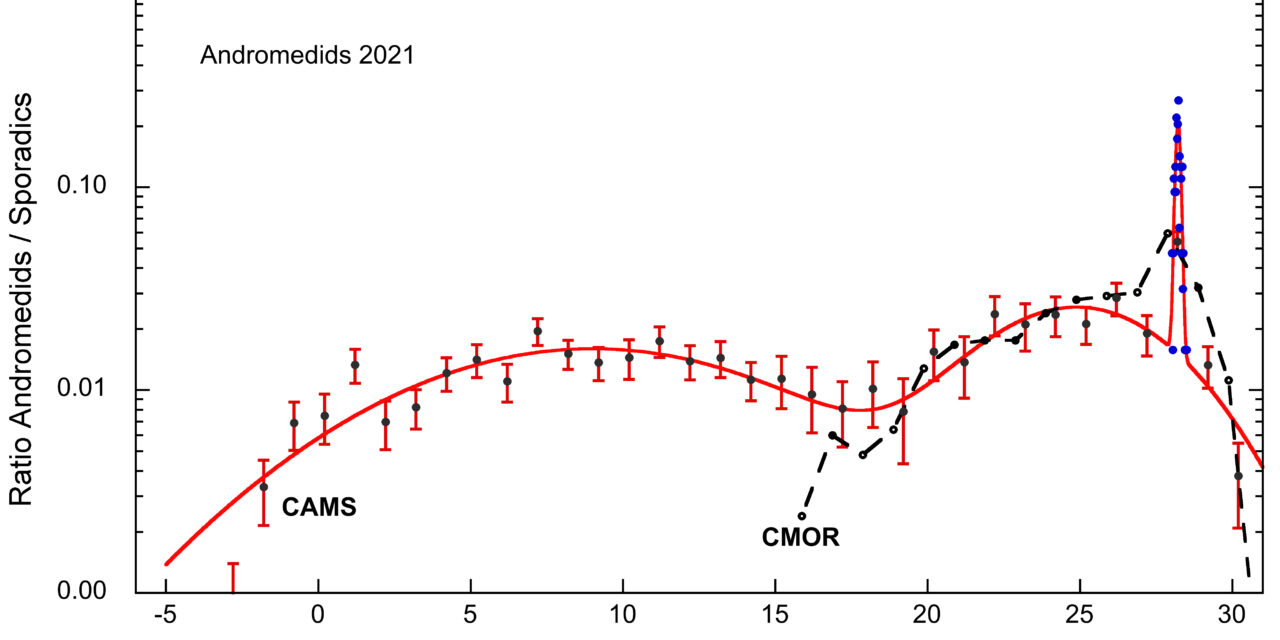

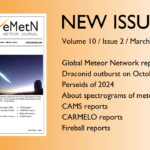
Wow after last night’s Geminids I realized that I caught a very bright meteor on the night of nov 28. Naked eye prob between 8-9pm est central Virginia.